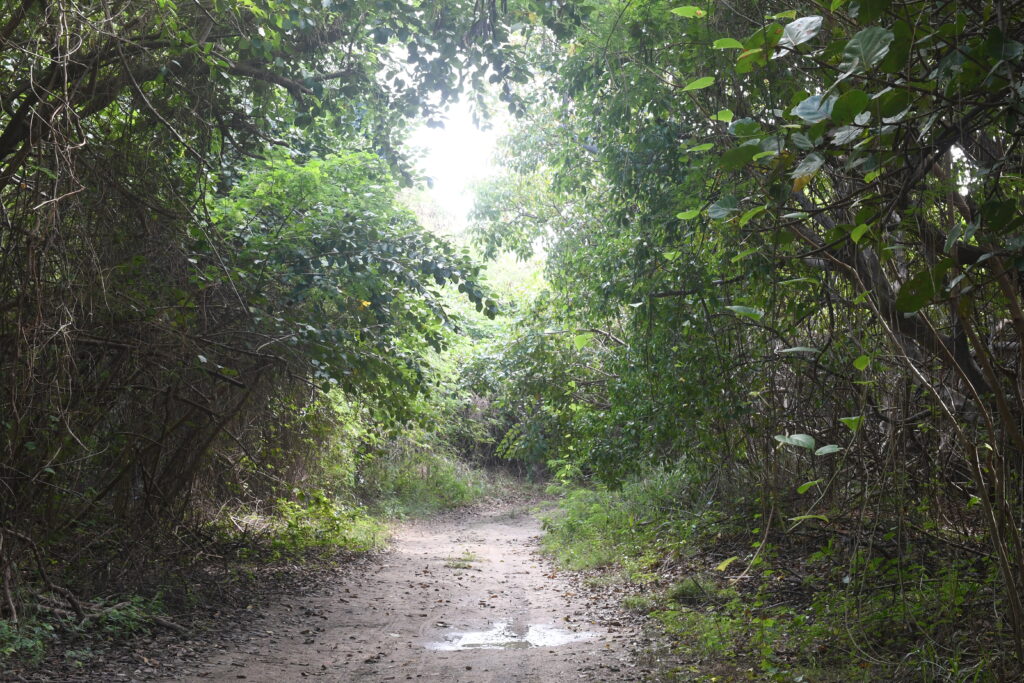At A Glance
Affiliates
Archives


Barbados is currently participating in the Wetlands for the Future initiative which focuses on enabling activities for education, training, conservation, and documentation of wetlands. Funding was awarded to produce an inventory of the island’s wetlands and the species that are found in them, along with a management plan for Long Pond. The Long Pond wetland is a coastal estuarine lagoon formed by the Bruce Vale and Walkers Rivers, and is home to numerous species of birds, crustaceans, insects, molluscs, and plants. Here, we will take you on a virtual stroll around Long Pond and its surroundings to introduce you to a fraction of its biodiversity.

Long Pond is one of Barbados’ last remaining east coast wetlands, and its watershed is the largest on the east coast. Just off Ermy Bourne Highway, nestled between the village of Belleplaine and Walkers Reserve in St. Andrew, this wetland is quite accessible. A muddy path leads through coastal woodlands dominated by clammy cherry (Cordia obliqua), river tamarind (Leucaena leucocephala) and manchineel (Hippomane mancinella) trees to a wide-open grassland.

This grassland is carpeted with short grasses and herbs like carpet daisy (Sphagneticola trilobata), pitted bluestem grass (Bothriochloa pertusa), crab grass (Sporobolus virginicus), and zoysia grass (Zoysia tenuifolia). Amongst these more common grasses are scattered bunches of small wildflowers such as devil bean (Crotalaria retusa), duppy needles (Bidens alba), Tephrosia purpurea, mimosa (Mimosa pudica) and sage (Lantana camara). The nectar from these plants is collected by honeybees (Apis mellifera) which in turn pollinate each flower.


Feeding on these grasses and other vegetation are domestic cattle put out to graze. Grazing animals can have negative impacts on some ecosystems, including wetlands. Grazing can damage more delicate plants and hinder their natural development in the ecosystem, providing an opportunity for others to dominate. This can significantly change the character of the environment which can limit the success of ecological restoration initiatives.

Straight ahead is the Long Pond lagoon which is filled with water year-round. As you walk towards the pond, you will see small Burger’s fiddler crabs (Minuca burgersi) scuttling in the mud around smaller puddles. These little crabs play an important role as decomposers, feeding on algae and decaying materials, and also as food for birds.

The pond stretches towards the beach where there is a natural sandbar at the mouth of the river. This sandbar helps the pond retain water, providing habitat for many aquatic animals. The water level is highly variable, and the pond can flood the surrounding grasslands after heavy rains. The pond occasionally naturally breaks the sandbar, releasing excess water into the ocean creating a new equilibrium. This waterway is constantly in a state of flux, changing significantly over time.



Have you ever wondered why wetlands are so attractive to migratory birds? The dead plant leaves and stems break down in the water to form small organic materials known as detritus. Many small aquatic insects, crabs, shrimp, and fish feed on detritus which are in turn preyed on by larger predatory animals, particularly wading birds. Barbados is a temporary stop for over 200 migratory birds traversing the Atlantic Flyway in need of food and rest. Some of these species are in decline. The Near Threatened red knot (Calidris canutus) and buff-breasted sandpiper (Calidris subruficollis) are two such vulnerable species of note.

Walking towards the beach you notice coconut (Cocos nucifera) groves and coastal scrub, composed mainly of sea grape (Coccoloba uvifera) and fat pork (Chrysobalanus icaco) with thickets of noni (Morinda citrifolia), French cotton (Calotropis procera) and seaside sage (Croton flavens). Sea grape and fat pork plants both produce fruits loved by many. Both fruit turn reddish-purple as they ripen, though the firmness of fat porks must also be considered. A firm fat pork is under-ripe and likely to taste astringent and “tie up ya mout” as Bajans say.

Much of the beach is covered by a thick carpet of goatsfoot yam (Ipomoea pes-caprae), seaside samphire (Sesuvium portulacastrum), Blutaparon vermiculare, crab grass and seaside bean (Canavalia rosea). These pioneer plants form the renowned dunes of the area by trapping sand, thereby stabilising the beach. These pioneer plants are the first stages in the succession of coastal vegetation. As they die and decompose, they release organic nutrients and enrich the soil until, after some time, it is able to sustain larger and more complex plants. This dune habitat is uncommon on islands, and Long Pond boasts one of the only dune ecosystems in the Caribbean islands.

On the beach is another commonly seen crab, the Atlantic ghost crab (Ocypode quadrata). These crabs chase the tides to forage on small clams, sea cockroaches (Emerita talpoida), insects, sea turtle hatchlings, and organic material washed ashore. Though they’re terrestrial, these crabs still need to moisten their gills and release their eggs in the sea.

Walking north, you will see some of the more impressive dunes. Two signs are erected here which ask visitors to refrain from driving on the dunes. Vehicle tires can significantly damage the dune ecosystems by destroying the vegetation necessary to keep sand in place. The gradual regeneration of the dune ecosystem at Walkers Beach is a triumph, and a testament to the ability of natural ecosystems to rebound when stressors are removed.

Heavy vehicles and other machinery on the beach also endanger the nests of turtles. Both the hawksbill (Eretmochelys imbricata) and leatherback turtle (Dermochelys coriacea) are known to nest on the east coast, but leatherbacks are more common in the area. Leatherback turtles are thought to mainly nest on the east coast of the island because here the turbulent Atlantic waves help to push their massive weight up the beach. Females clamber up the beach and dig a hole a metre deep where she lays around 80 fertilised eggs. This may appear deep enough to protect the eggs, but vehicles compact the sand over the nest not only damaging eggs but also making it more difficult for the babies to emerge after hatching.


Continuing along the northern bank of the pond, you reach some of the most important flora of the ecosystem. Long Pond boasts the only black mangrove (Avicennia germinans) known to exist in Barbados, a single grove lies across the water on the south-western bank of the lagoon. These mangroves have characteristic pneumatophores, aerating roots which grow up from the mud and allow the plant to breathe air in the waterlogged soil.


Following the trail further inland, red mangrove (Rhizophora mangle) saplings begin to appear. When fully grown trees, these mangroves grow on prop roots which suspend the plant over the water to provide support and avoid hypoxia. Finally, further in, there is a large thicket of white mangroves (Laguncularia racemosa) growing along the Walkers River. These mangroves may have either prop roots or pneumatophores, depending on the conditions, but are known to grow inland of other mangroves. Collectively, the complex root systems of the mangroves trap sediment in the water and protect the coast from erosion. These trees form the backbone of many wetland ecosystems and were once common along the south and west coasts of Barbados.

Amongst the wet mud of these areas, you will see many large holes and accompanying mounds. These are crab holes where the large blue land crab (Cardisoma guanhumi), also known as the swampy, dwells. Their holes extend down to the water table so they can moisten their gills to breathe. Though they are terrestrial, they must migrate to the sea to release their eggs into the water. They remain in the shade during the daytime and will often forage at night to escape the sun. Growing up to 6 inches in carapace length, these large land crabs are commonly harvested to eat. Traditionally, crabs are “purged” before consumption, a process involving feeding the captured crab vegetation matter for a period of time before cooking.

Proceeding further along Walkers River, the woodland gets thick with clammy cherry, manchineel, and seaside mahoe (Thespesia populnea) supporting crab eye (Abrus precatorius) and sucking bottle (Paullinia cururu) vines. Underfoot, red (Trigoniulus corallinus) and brown (Orthoporus antillanus) millipedes are common in the thick layers of decomposing leaf litter. Millipedes, along with snails and slugs, are important decomposers of leaf litter. By feeding on and expelling detritus, they enrich the soil which provides nutrients to plants. In the trees and vines you may also be lucky enough to see a stick insect, or godhorse as Bajans know them.



The woodlands are an important part of the coastal vegetation profile and provide benefits by keeping the local temperature cool, stabilizing the soil and preventing erosion and loss of topsoil, sequestering carbon, providing a home to a wide variety of life, and giving people a relaxing, natural environment to enjoy through hikes, nature walks, bird and other wildlife spotting, and photography.

These dune, woodland, grassland, and lagoon components are important parts of the entire Long Pond ecosystem. Together, they form a large, continuous and interconnected natural area where animals can traverse unhindered. The variety of landscapes and their potential contributions to the island’s natural capital cannot be understated. Whether you are a fisherman, crabber, hiker, camper, photographer, naturalist, artist, forager, researcher or beach goer, Long Pond has something for you.





Very impressive.I arrived from walkers st.Andrew but migrated to United States in 1981.I’m a frequent visitor to the island and i always stay in st.Andrew. I’ve always considered it to be the most beautiful parish in Barbados because of its natural beauty.It’s really nice to see it’s finally getting the acknowledgement it truly deserves.